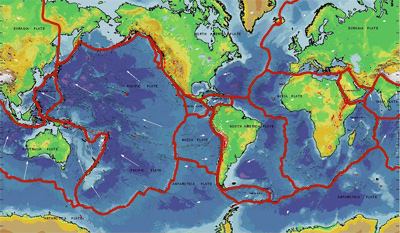A map of Earth's tectonic plates. Plate boundaries are shown in red. Learn more about the geologic features related to Earth's tectonic plates at
This Dynamic Planet.
Click on image for full size
Modified from USGS
Plate Tectonics
The main force that shapes our planet's surface over long amounts of time is the movement of Earth's outer layer by the process of plate tectonics.
This picture shows how the rigid outer layer of the Earth, called the lithosphere, is made of plates which fit together like a jigsaw puzzle. These plates are made of rock, but the rock is, in general, lightweight compared with the denser, fluid layer underneath. This allows the plates to "float" on top of the denser material.
Movements deep within the Earth, which carry heat from the hot interior to the cooler surface, cause the plates to move very slowly on the surface, about 2 inches per year. There are several different hypotheses to explain exactly how these motions allow plates to move.
Interesting things happen at the edges of plates. Subduction zones form when plates crash into each other, spreading ridges form when plates pull away from each other, and large faults form when plates slide past each other.
You might also be interested in:

Many kinds of surface features are clues that our lithosphere is sliding. Two types of features can form when plates move apart. At mid ocean ridges, the bottom of the sea splits apart and new crust is
...more
Plates at our planet’s surface move because of the intense heat in the Earth’s core that causes molten rock in the mantle layer to move. It moves in a pattern called a convection cell that forms when
...more
When two sections of the Earth's crust collide, one slab of crust can be forced back down into the deeper regions of the Earth, as shown in this diagram. This process is called subduction. The slab that
...more
A team of scientists from the United States was invited to visit Haiti in late January 2010 to look into the cause of the magnitude 7 earthquake that happened there. While there, the geologists will collect
...more
The expression "on solid ground" is often used to describe something as stable. Usually the solid ground underfoot seems very stable. But sometimes it is not. "The ground seemed to twist under us like
...more
There are lots of rocks in Antarctica, but the one that scientists just found is special. It may provide evidence that part of Antarctica was connected to North America hundreds of millions of years ago.
...more
As the Earth cools, hot material from the deep interior rises to the surface. Hot material is depicted in red in this drawing, under an ocean shown in blue green. The hotter material elevates the nearby
...more















